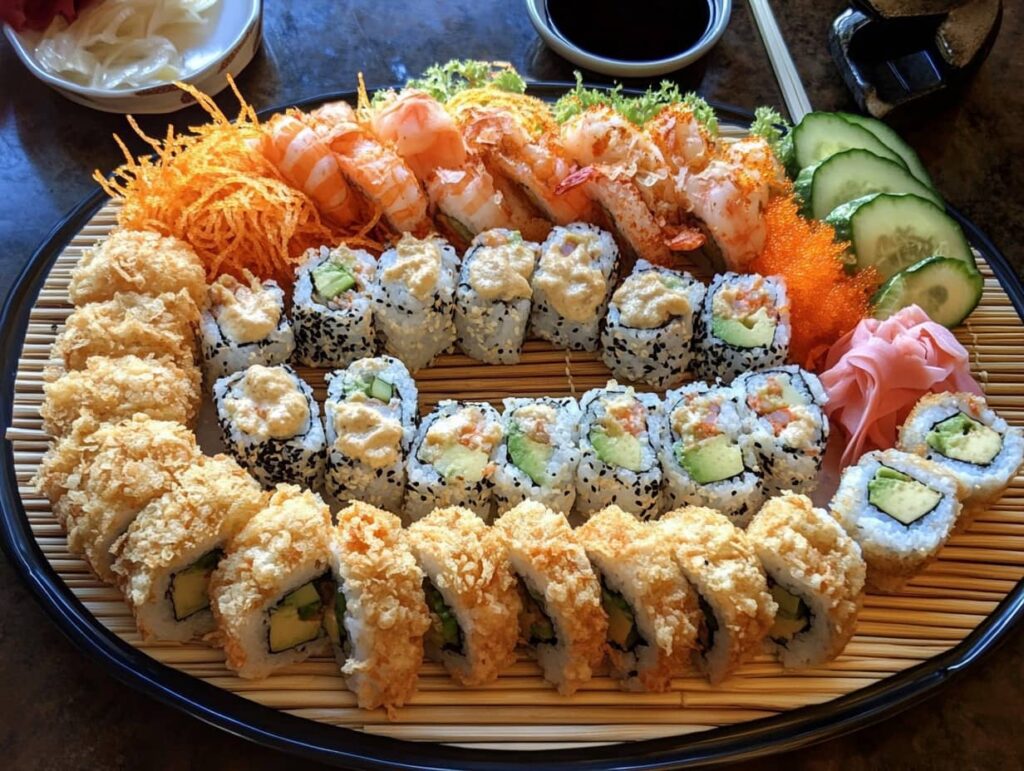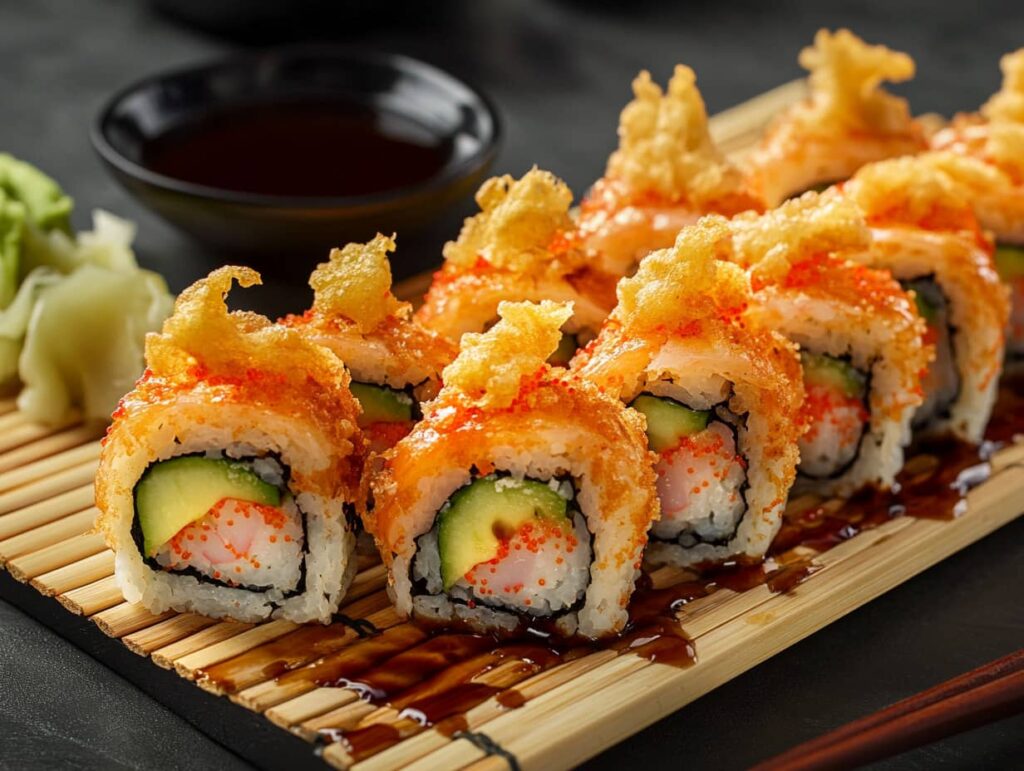Tempura rolls are one of the most beloved types of sushi, combining the crispy texture of tempura with the traditional flavors of Japanese cuisine. These rolls are a fusion dish, blending classic sushi ingredients with a twist of deep-fried goodness. They have gained immense popularity worldwide, appealing to sushi lovers who crave something both crunchy and flavorful.
This article will dive into what a tempura roll is, the ingredients used to make it, and why it stands out among other sushi varieties. Whether you’re a sushi enthusiast or a curious beginner, you’ll learn all about this delightful dish and even get tips on how to enjoy it best! If you’re interested in variations, check out our guide to Chicken Tempura Rolls for a unique twist on the classic recipe.
Table of contents
What Is a Tempura Roll?
A tempura roll is a type of sushi that features tempura-fried ingredients, typically wrapped in sushi rice and nori (seaweed). Unlike traditional sushi rolls that rely on raw or lightly cooked ingredients, tempura rolls stand out due to their crispy, golden exterior.
The defining feature of a tempura roll is its use of tempura batter. This batter is light and airy, creating a crisp texture when deep-fried. Tempura rolls are often made with shrimp, vegetables, or other seafood as the star ingredient. The combination of warm, crunchy tempura and cool, fresh rice delivers a unique and satisfying experience.
How Tempura Rolls Differ From Regular Sushi
- Cooking Method: Regular sushi often includes raw fish, while tempura rolls use fried ingredients.
- Texture: Tempura rolls offer a mix of crispiness from frying and softness from rice and fillings.
- Flavors: The fried components add a rich, savory flavor that complements traditional sushi elements.
Tempura rolls are an excellent choice for those who might be hesitant to try raw fish, offering a balance of traditional and approachable flavors.
Ingredients :
| Ingredient | Measurement (Per Roll) | Purpose |
|---|---|---|
| Shrimp or Other Protein | 2–3 medium-sized pieces | Provides the main flavor and texture. |
| Vegetables (e.g., Avocado, Cucumber) | 2–3 thin slices each | Adds freshness, crunch, or creaminess. |
| Tempura Batter | 1/2 cup | Creates a crispy coating for frying. |
| Sushi Rice | 1 cup cooked | Forms the base of the roll, holding the nori and filling together. |
| Nori (Seaweed) | 1 full sheet | Holds the roll’s structure and adds a subtle salty flavor. |
| Cream Cheese (Optional) | 1–2 tablespoons | Enhances creaminess and balances crispy textures. |
| Spicy Mayo or Eel Sauce | 1 tablespoon | Drizzled on top for extra flavor and richness. |
| Pickled Ginger | Small pinch (as needed) | Cleanses the palate between bites. |
| Wasabi | Small dab (optional) | Adds heat and enhances flavor. |
| Cooking Oil | Enough for deep frying (about 2 cups) | Ensures even frying of the tempura batter. |
These measurements are approximate and can vary depending on personal preference and portion size. With these ingredients prepared, you’re all set to make a tempura roll that’s as delicious as it is satisfying!
How Tempura Rolls Are Made
Making a tempura roll is an art that combines careful preparation with simple techniques. Whether you’re a beginner or an experienced cook, you can create this dish with the right steps. Below is a detailed process to guide you.
1. Prepare the Ingredients
Before you begin assembling, gather and prepare all the necessary ingredients:
- Cook the sushi rice: Rinse 1 cup of sushi rice until the water runs clear, then cook it using a rice cooker or stovetop. Once cooked, season with 2 tablespoons of rice vinegar, 1 tablespoon of sugar, and a pinch of salt. Let it cool.
- Slice the vegetables: Thinly slice cucumber, avocado, or any other desired vegetables.
- Peel and devein shrimp: If using shrimp, ensure they’re cleaned and ready for frying.
2. Make the Tempura
- Prepare the batter: Mix 1/2 cup of all-purpose flour, 1/2 cup of cold water, and 1 egg in a bowl. Stir lightly—don’t overmix, as the batter should remain slightly lumpy for the best texture.
- Heat the oil: Pour about 2 cups of cooking oil into a deep pan or fryer. Heat it to 350°F (175°C) to ensure even frying.
- Fry the shrimp or vegetables: Dip each piece into the tempura batter, ensuring it’s fully coated. Gently place it in the hot oil and fry for 2–3 minutes or until golden brown. Remove and drain on a paper towel.
3. Assemble the Roll
- Place the nori: Lay a sheet of nori (seaweed) shiny side down on a bamboo rolling mat.
- Spread the rice: Cover the nori evenly with a thin layer of seasoned sushi rice. Use wet hands to prevent sticking.
- Add fillings: Lay the tempura-fried shrimp or vegetables in the center, along with sliced avocado, cucumber, or cream cheese if desired.
4. Roll It Up
- Roll tightly: Using the bamboo mat, gently lift the edge of the nori and roll it over the fillings, pressing firmly to keep the roll tight. Continue rolling until the seam is underneath.
- Seal the roll: Dab a little water on the edge of the nori to seal it.
5. Slice and Serve
- Cut the roll: Use a sharp knife to cut the roll into 6–8 pieces. Wipe the blade with a damp cloth between cuts for clean slices.
- Add toppings: Drizzle with spicy mayo or eel sauce for extra flavor.
- Serve: Arrange the pieces on a plate with pickled ginger and wasabi on the side.
This step-by-step process ensures your tempura rolls are crisp, flavorful, and ready to impress!
Types of Tempura Rolls

| Type of Tempura Roll | Description | Toppings |
|---|---|---|
| Shrimp Tempura Roll | Features tempura-fried shrimp with avocado and cucumber. | Spicy mayo, eel sauce, or sesame seeds. |
| Vegetable Tempura Roll | Includes tempura-fried vegetables like sweet potato, asparagus, or zucchini. | Light soy sauce or ponzu. |
| Spicy Tempura Roll | Combines tempura shrimp or fish with spicy mayo or Sriracha for heat. | Sliced jalapeños or chili oil. |
| Crab Tempura Roll | Filled with tempura-fried crab or imitation crab for a sweet-savory flavor. | Avocado slices or tobiko (fish roe). |
| Dragon Tempura Roll | Features tempura shrimp or fish, layered with avocado and cucumber. | Thinly sliced avocado resembling dragon scales. |
| Eel Tempura Roll | Made with tempura-fried eel, offering a rich and smoky flavor. | Sweet eel sauce. |
| California Tempura Roll | A tempura twist on the classic California roll, with imitation crab and avocado. | Sesame seeds or spicy mayo. |
| Custom Tempura Rolls | Build-your-own rolls with favorite proteins, vegetables, and toppings. | Cream cheese, mango, teriyaki sauce, etc. |
Nutritional Information of Tempura Rolls
Tempura rolls are delicious, but understanding their nutritional content can help you make informed choices. Here’s a breakdown of the typical nutritional values found in tempura rolls, based on common ingredients and portions.
| Nutrient | Shrimp Tempura Roll (Per Roll) | Vegetable Tempura Roll (Per Roll) | Notes |
|---|---|---|---|
| Calories | 300–400 kcal | 250–350 kcal | Calories vary based on fillings and sauces. |
| Protein | 10–15 g | 5–8 g | Shrimp and fish rolls have more protein than veggies. |
| Fat | 10–18 g | 8–15 g | Comes from tempura batter and frying process. |
| Carbohydrates | 40–50 g | 35–45 g | Mostly from rice and vegetables. |
| Fiber | 2–3 g | 3–4 g | Vegetables add more fiber. |
| Sugar | 1–3 g | 1–2 g | Minimal sugar unless sweet toppings are added. |
| Sodium | 600–800 mg | 500–700 mg | Increases with sauces like soy or eel sauce. |
Key Considerations
- Calories: Tempura rolls are higher in calories compared to traditional sushi rolls due to frying.
- Protein: Rolls with seafood like shrimp or fish provide more protein, making them a good option for those looking to boost protein intake.
- Fat Content: The tempura frying process adds fat. Opt for light toppings or no sauces if reducing fat is a goal.
- Sodium: Soy sauce and eel sauce can increase sodium levels significantly, so use them sparingly if watching sodium intake.
- Vegetarian Options: Vegetable tempura rolls are lighter and contain less protein but are a great source of fiber and vitamins.
How Tempura Rolls Fit Into a Balanced Diet
- Moderation is Key: Enjoy tempura rolls occasionally as part of a balanced diet.
- Pair with Light Sides: Combine with a side salad or miso soup to create a more balanced meal.
- Custom Adjustments: Opt for baked or grilled ingredients to reduce calories and fat if needed.
Frequently Asked Questions (FAQs)
Here are some common questions about tempura rolls and their answers to help clarify any doubts:
1. Can I make tempura rolls at home?
Yes, tempura rolls can be made at home with a few basic ingredients and tools. You’ll need sushi rice, nori, tempura batter, and your choice of fillings. A bamboo rolling mat will help you roll everything together.
2. Are tempura rolls healthy?
Tempura rolls can be part of a healthy diet when enjoyed in moderation. While they are higher in calories and fat due to frying, they also provide protein and nutrients from the seafood and vegetables.
3. What is the difference between tempura rolls and regular sushi rolls?
The main difference is the cooking method. Tempura rolls feature deep-fried ingredients for a crispy texture, while regular sushi rolls usually include raw or lightly cooked components.
4. Can I use different types of seafood or vegetables in a tempura roll?
Absolutely! Shrimp is the most common filling, but you can use other seafood like crab, fish, or scallops. For vegetables, sweet potato, asparagus, and zucchini are great choices.
5. How do I keep the tempura crispy when making rolls?
To keep tempura crispy:
- Use cold batter.
- Fry at the correct temperature (350°F or 175°C).
- Let the fried ingredients cool slightly before rolling to avoid moisture.
6. What sauces go best with tempura rolls?
Spicy mayo, eel sauce, and ponzu are popular options. Soy sauce can also be used for dipping. Each sauce adds a unique flavor to enhance the roll.

Conclusion
Tempura rolls are a delightful fusion of flavors and textures, blending the crispiness of tempura with the traditional elements of sushi. Whether filled with shrimp, vegetables, or other ingredients, these rolls offer something for everyone to enjoy.
Their versatility and appeal make them a favorite in Japanese cuisine and beyond. From the light crunch of tempura batter to the creamy and savory fillings, every bite is a burst of flavor. With the right ingredients and a bit of practice, you can even create your own tempura rolls at home, customizing them to suit your taste.
Whether you’re enjoying them at a sushi restaurant or experimenting in your kitchen, tempura rolls are sure to bring joy to your table. So, why not try making or ordering one today and savor the irresistible combination of crispy and fresh?

